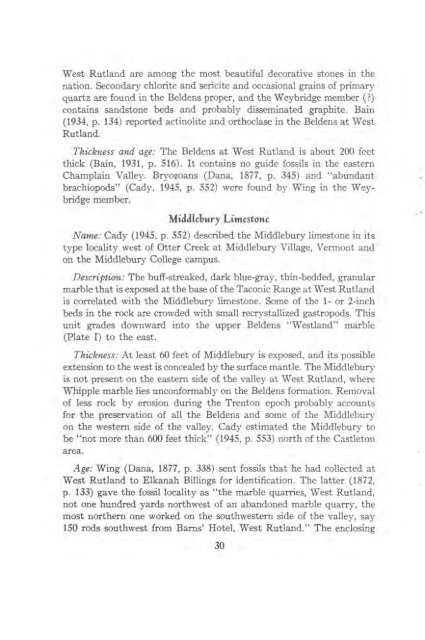STRATIGRAPHY AND STRUCTURE CASTLETON AREA VERMONT
STRATIGRAPHY AND STRUCTURE CASTLETON AREA VERMONT
STRATIGRAPHY AND STRUCTURE CASTLETON AREA VERMONT
You also want an ePaper? Increase the reach of your titles
YUMPU automatically turns print PDFs into web optimized ePapers that Google loves.
West Rutland are among the most beautiful decorative stones in the<br />
nation. Secondary chlorite and sericite and occasional grains of primary<br />
quartz are found in the Beldens proper, and the Weybridge member (?)<br />
contains sandstone beds and probably disseminated graphite. Bain<br />
(1934, p. 134) reported actinolite and orthoclase in the Beldens at West<br />
Rutland.<br />
Thickness and age: The Beldens at West Rutland is about 200 feet<br />
thick (Bain, 1931, p. 516). It contains no guide fossils in the eastern<br />
Champlain Valley. Bryozoans (Dana, 1877, p. 345) and "abundant<br />
brachiopods" (Cady, 1945, p. 552) were found by Wing in the Wey -<br />
bridge member.<br />
Middlehury Limestone<br />
Name: Cady (1945, p. 552) described the Middlebury limestone in its<br />
type locality west of Otter Creek at Middlebury Village, Vermont and<br />
on the Middlebury College campus.<br />
Description: The buff-streaked, dark blue-gray, thin-bedded, granular<br />
marble that is exposed at the base of the Taconic Range at West Rutland<br />
is correlated with the Middlebury limestone. Some of the 1- or 2-inch<br />
beds in the rock are crowded with small recrystallized gastropods. This<br />
unit grades downward into the upper Beldens "Westland" marble<br />
(Plate I) to the east.<br />
Thickness: At least 60 feet of Middlebury is exposed, and its possible<br />
extension to the west is concealed by the surface mantle. The Middlebury<br />
is not present on the eastern side of the valley at West Rutland, where<br />
Whipple marble lies unconformably on the Beldens formation. Removal<br />
of less rock by erosion during the Trenton epoch probably accounts<br />
for the preservation of all the Beldens and some of the Middlebury<br />
on the western side of the valley. Cady estimated the Middlebury to<br />
be "not more than 600 feet thick" (1945, p. 553) north of the Castleton<br />
area.<br />
Age: Wing (Dana, 1877, p. 338) sent fossils that he had collected at<br />
West Rutland to Elkanah Billings for identification. The latter (1872,<br />
p. 133) gave the fossil locality as "the marble quarries, West Rutland,<br />
not one hundred yards northwest of an abandoned marble quarry, the<br />
most northern one worked on the southwestern side of the valley, say<br />
150 rods southwest from Barns' Hotel, West Rutland." The enclosing<br />
30













